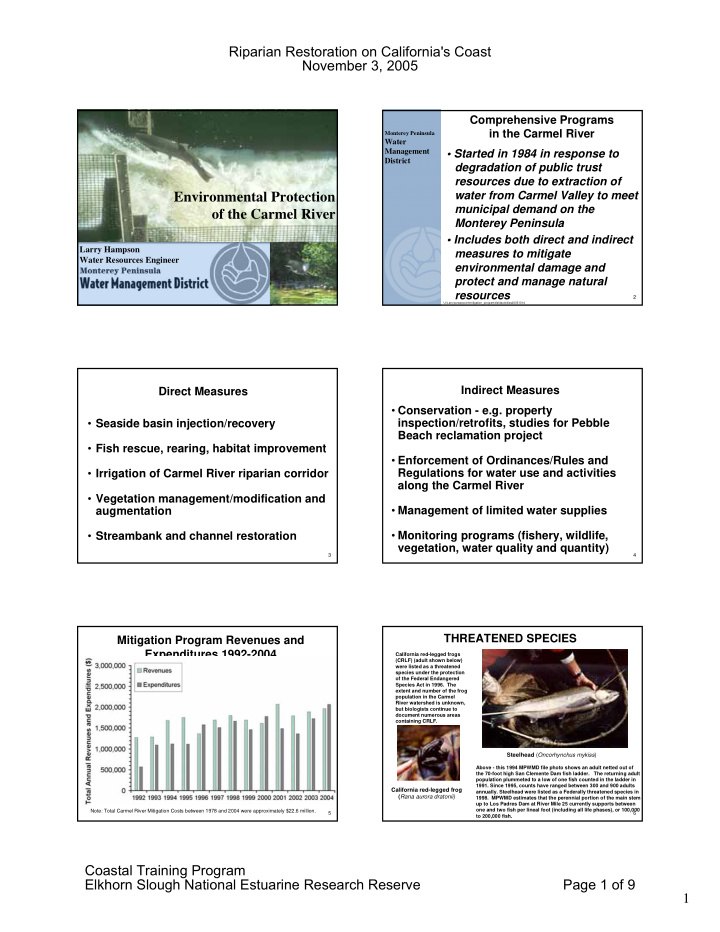



Riparian Restoration on California's Coast November 3, 2005 Comprehensive Programs in the Carmel River Monterey Peninsula Water Management • Started in 1984 in response to District degradation of public trust resources due to extraction of water from Carmel Valley to meet Environmental Protection municipal demand on the of the Carmel River Monterey Peninsula • Includes both direct and indirect Larry Hampson measures to mitigate Water Resources Engineer environmental damage and protect and manage natural resources 1 2 U:\Larry\powerpoint\mitigation_program\fieldactivities20051014 Indirect Measures Direct Measures • Conservation - e.g. property • Seaside basin injection/recovery inspection/retrofits, studies for Pebble Beach reclamation project • Fish rescue, rearing, habitat improvement • Enforcement of Ordinances/Rules and Regulations for water use and activities • Irrigation of Carmel River riparian corridor along the Carmel River • Vegetation management/modification and • Management of limited water supplies augmentation • Monitoring programs (fishery, wildlife, • Streambank and channel restoration vegetation, water quality and quantity) 3 4 THREATENED SPECIES Mitigation Program Revenues and Expenditures 1992-2004 California red-legged frogs (CRLF) (adult shown below) were listed as a threatened species under the protection of the Federal Endangered Species Act in 1996. The extent and number of the frog population in the Carmel River watershed is unknown, but biologists continue to document numerous areas containing CRLF. Steelhead ( Oncorhynchus mykiss ) Above - this 1994 MPWMD file photo shows an adult netted out of the 70-foot high San Clemente Dam fish ladder. The returning adult population plummeted to a low of one fish counted in the ladder in 1991. Since 1995, counts have ranged between 300 and 900 adults California red-legged frog annually. Steelhead were listed as a Federally threatened species in ( Rana aurora dratonii) 1998. MPWMD estimates that the perennial portion of the main stem up to Los Padres Dam at River Mile 25 currently supports between one and two fish per lineal foot (including all life phases), or 100,000 Note: Total Carmel River Mitigation Costs between 1978 and 2004 were approximately $22.6 million. 5 6 to 200,000 fish. Coastal Training Program Elkhorn Slough National Estuarine Research Reserve Page 1 of 9 1
Riparian Restoration on California's Coast November 3, 2005 Streamflow Monitoring Carmel River Restoration Planting •18 continuous recording stations •USGS standards •Remote access to real time streamflow data Flow measurement using a bridge crane. Benefits: MPWMD employees plant native vegetation along the Carmel River to provide river bank stabilization •Water supply planning and habitat. Between 1983 and 2001, more than •Hydrologic modeling seven miles of streambanks were revegetated. •Early flood warning •Monitoring water use 7 Measuring flow with wading rod and current meter. 8 Factors in Steelhead Decline Gravel Injection Program Mitigation for Habitat Loss • Inadequate passage facilities at Los Padres • Injection program replaces gravel retained by Dam main stem reservoirs • Dry season diversions at San Clemente Dam • 4,000 tons of material placed since 1993 • Pumping of streamflow and groundwater • Loss of surface storage capacity in main stem reservoirs • Reduction in the extent and diversity of streamside vegetation Placing spawning gravel through the bridge at the Los Padres Dam spillway. A backhoe pushes spawning gravel into pool near fish ladder. 9 10 Los Padres Dam Passage Factors in Steelhead Decline (continued) • Reduced amounts of large wood • Sediment retention in main stem reservoirs • Sedimentation of habitat from chronic and episodic bank erosion • Blockage of smolt emigration • Sedimentation in the Carmel River Lagoon 11 12 Coastal Training Program Elkhorn Slough National Estuarine Research Reserve Page 2 of 9 2
Riparian Restoration on California's Coast November 3, 2005 Carmel Valley Water Production Dry Season Diversions 1915-2004 Historical Surface Diversion at San Clemente Dam and Streamflow at Robles del Rio Cal-Am Water Production by Source: 1916-2004 May-October 1981 Surface Diversion Carmel Valley Aquifer Diversion at San Clemente Dam (cfs) Streamflow @ Robles del Rio (cfs) 20,000 60 Note: "Cal-Am" refers to the California-American Water and its predecessor 50 15,000 40 Flow (cfs) Acre-Feet 10,000 30 20 5,000 10 0 1-May 29-May 26-Jun 24-Jul 21-Aug 18-Sep 16-Oct 0 1915 1920 1925 1930 1935 1940 1945 1950 1955 1960 1965 1970 1975 1980 1985 1990 1995 2000 Date Water Year Source: Daily Cal-Am report of net system delivery and USGS historical streamflow data for station No.11143200 Production values for the 1916-1978 period from Cal-Am Exhibit 90 at the 1992 State Water Resources Control Board hearings regarding Cal-Am's diversions from the Carmel River 13 14 system. Production for the 1978-2004 period were compiled by the Monterey Peninsula Water Management District from monthly production reports submitted by the Cal-Am's Monterey Division. Summer/Fall Pumping in the September 2005 Carmel Valley Alluvial Aquifer Except in extremely wet years, groundwater pumping causes a portion of the river to dry up annually. Right - a well located in the bottom of the channel, nine miles upstream of the ocean. Sept. 1984 Sedimentation in Up to 15 miles were annually dewatered prior to 1985. After the San Clemente addition of wells closer to the end of the river, pumping was shifted Reservoir downstream, resulting in fewer miles of river going dry and perennial flow May 2002 15 16 July 1982 in this reach. Streambank Vegetation Percentage of Carmel River Streambanks Covered with Riparian Vegetation, 1956 and 1980 100% 90% 80% 70% 1956 Percentage 60% 1980 1991 50% 2003 40% 30% 20% 10% 0% 0.00 2.00 4.00 6.00 8.00 10.00 12.00 14.00 16.00 Location (River Mile) San Clemente Dam Adapted from Figure D-5, Li (1 983) and based on measurements of the lineal extent of vegetation from aerial photographs. Data for 1 991 and 2003 based on measurements from delinated riparian vegetation on aerial photos of the Valley Hills Project by P. Watters. Range of values for 1 991 and 2003 shows variation from right to left streambanks. March 10, 1995 Q = 16,000 cfs 17 18 Coastal Training Program Elkhorn Slough National Estuarine Research Reserve Page 3 of 9 3
Recommend
More recommend